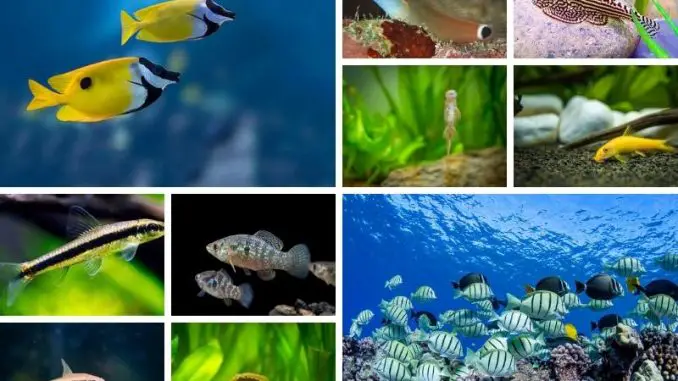
Algae eaters, also known as algivores, are aquarium dwellers that feed on algae. Some popular algae eaters are invertebrates like shrimp and snails, while other algae eaters are fish.
Different types of algae eaters behave differently, but most have a calm temperament and can live peacefully with a variety of other aquatic creatures.
Algae eaters are common in the pet trade, are easy to care for, and add diversity to the aquarium ecosystem.
TABLE OF CONTENTS
Algae-Eating Fish
In both freshwater and saltwater aquariums, algae-eating fish help keep the tank clean and healthy. Make sure to choose an algae-eating fish that matches the conditions of your tank.
Siamese Algae Eater
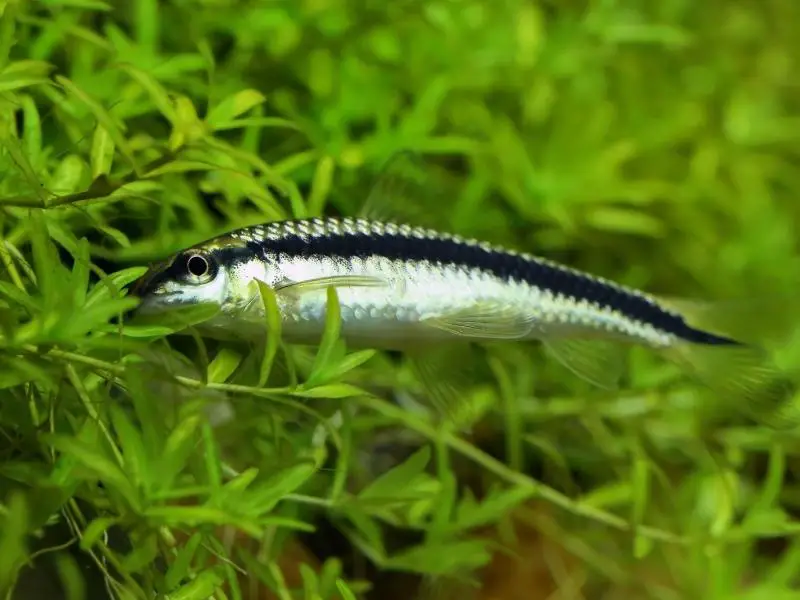
| Care level: | Temperament: | Color: | Lifespan: | Size: |
| Easy | Peaceful | Gold/grey | 3 years | 6 inches |
| Water temperature: | Water pH: | Tank size and water type: | Diet: | Scientific name: |
| 75–79°F | 6.5–8.0 | 20 gallons, freshwater | Omnivore | Crossocheilus oblongus |
The Siamese algae eater, Crossocheilus oblongus, is a freshwater fish native to the Southeast Asian countries of Malaysia and Thailand in basins of Mekong, Phraya, and Chao.
The peaceful, social, and active behaviors of the Siamese algae eater make it a popular choice among beginner aquarists.
Cover the Siamese algae eater’s aquarium with a lid to prevent the fish from jumping out. There are no special water flow requirements for Siam.
Chinese Algae Eater
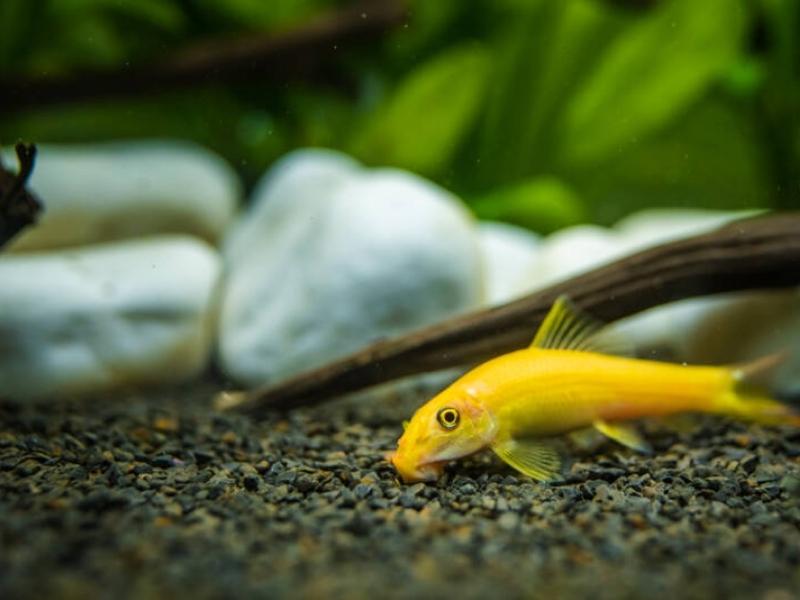
| Care level: | Temperament: | Color: | Lifespan: | Size: |
| Easy | Aggressive | Pale brown or golden | 10 years | 6–11 inches |
| Water temperature: | Water pH: | Tank size and water type: | Diet: | Scientific name: |
| 75–79°F | 6.5–8.0 | 50 gallons, freshwater | Omnivore | Gyrinocheilus aymonieri |
The Chinese algae eater, Gyrinocheilus aymonieri, is a freshwater fish native to Thailand’s Chao Phraya basin and fast-moving rivers of Laos, Thailand, and Vietnam.
The fish’s small dorsal fin with firm rays gives the Chinese algae eater a spiky appearance, making it popular among aquarium hobbyists.
The Chinese algae eater is a loner fish and will mostly keep to itself at the bottom of the tank, but the fish may exhibit aggressive behavior towards tank mates of the same species and those similar in size.
To prevent stress, use gravel and sand as a substrate and add some rocks and decorations for hiding spots.
Bristlenose Pleco
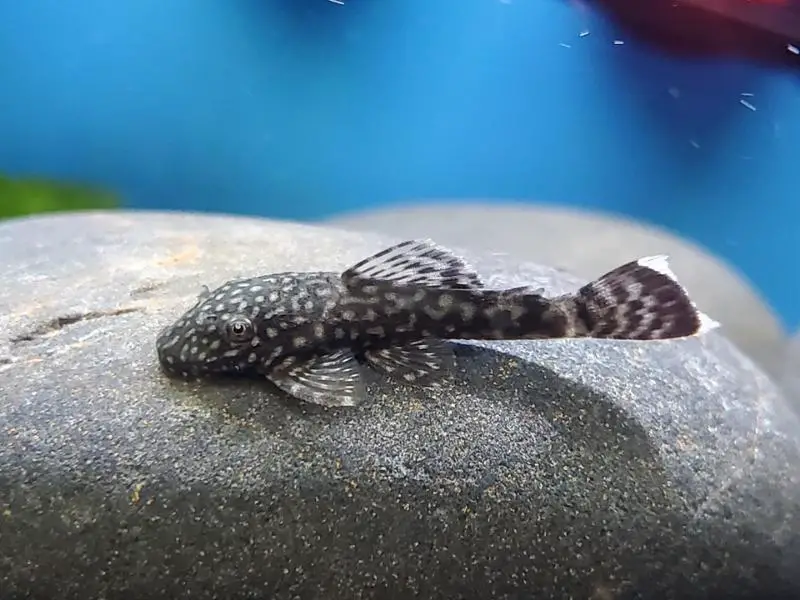
| Care level: | Temperament: | Color: | Lifespan: | Size: |
| Easy | Peaceful | Grey/black/brown | 5–12 years | 3–5 inches |
| Water temperature: | Water pH: | Tank size and water type: | Diet: | Scientific name: |
| 60–80°F | 6.5–7.0 | 40 gallons, freshwater | Omnivore | Ancistrus cirrhosus |
The bristlenose pleco, Ancistrus cirrhosis, is a freshwater fish native to tributaries and streams in the Amazon basin, but the fish is also found in South America.
The distinct bushy appendages sprouting from the snouts of bristlenose plecos make them popular among freshwater aquarium hobbyists and also inspired their name.
In captivity, bristlenose plecos survive primarily on algae and other plant matter. Supplementing their diet with occasional protein-based foods such as bloodworms keeps bristlenose plecos healthy and active.
Otocinclus Catfish
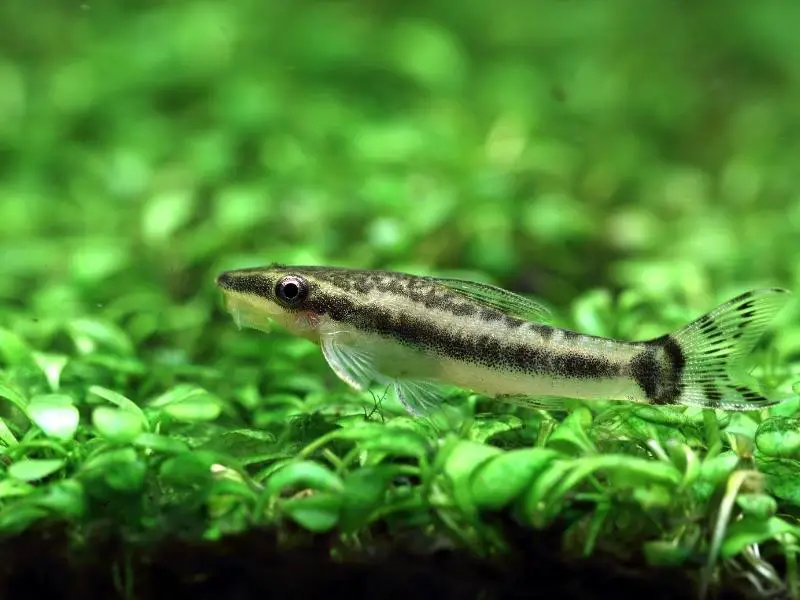
| Care level: | Temperament: | Color: | Lifespan: | Size: |
| Easy | Peaceful | White/grey with | 2–5 years | 2–3 inches |
| Water temperature: | Water pH: | Tank size and water type: | Diet: | Scientific name: |
| 68–78°F | 5.4–7.5 | 10 gallons, freshwater | Herbivore | Otocinclus vestitus |
The otocinclus catfish, Otocinclus vestitus, is a freshwater fish native to South America, notably Venezuela and Argentina.
Aquarium hobbyists love the algae-eating otocinclus catfish for its small size, peaceful nature, and ability to adapt well to aquarium life.
Otocinclus catfish spend most of their time at the bottom of the tank and try to keep away from larger, more aggressive tank mates.
Ensure that water hardness, temperature, and pH levels are constant, as changes can lead to stress and disease in otocinclus catfish.
Florida Flagfish
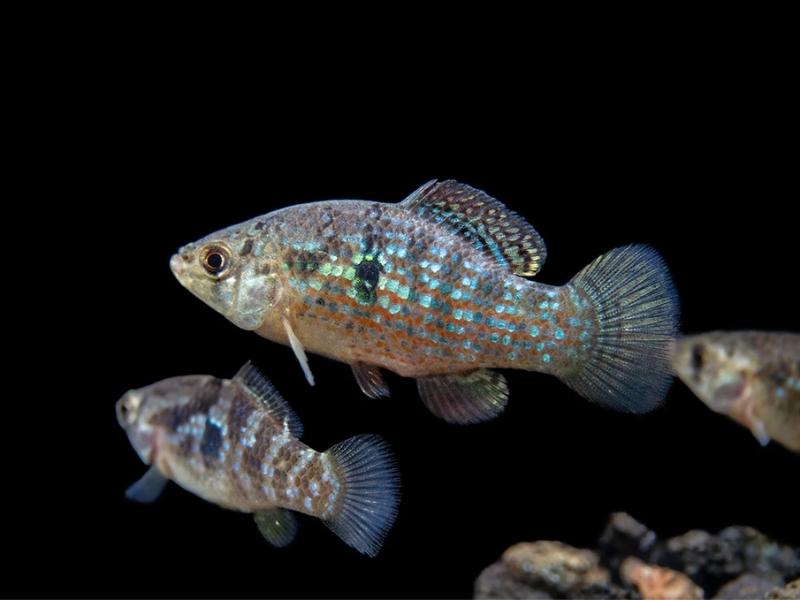
| Care level: | Temperament: | Color: | Lifespan: | Size: |
| Easy | Peaceful | Red stripes with luminescent | 2–3 years | 2.0–2.6 inches |
| Water temperature: | Water pH: | Tank size and water type: | Diet: | Scientific name: |
| 64–86°F | 6.5–8.0 | 20 gallons, freshwater | Omnivore | Jordanella floridae |
The Florida flagfish, Jordanella floridae, also known as the American flagfish, is a freshwater fish native to Florida in the St. John and Ochlockonee rivers.
Aquarium hobbyists and fishkeepers love the Florida flagfish for its vibrant colors and striking resemblance to the American flag.
Florida flagfish are peaceful fish suitable for a community aquarium, but they don’t do well with every freshwater tank mate, especially males of similar or other species.
Feeding is easy, as these fish eat common aquarium foods, including flake food, frozen food, and algae wafers.
Reticulated Hillstream Loach
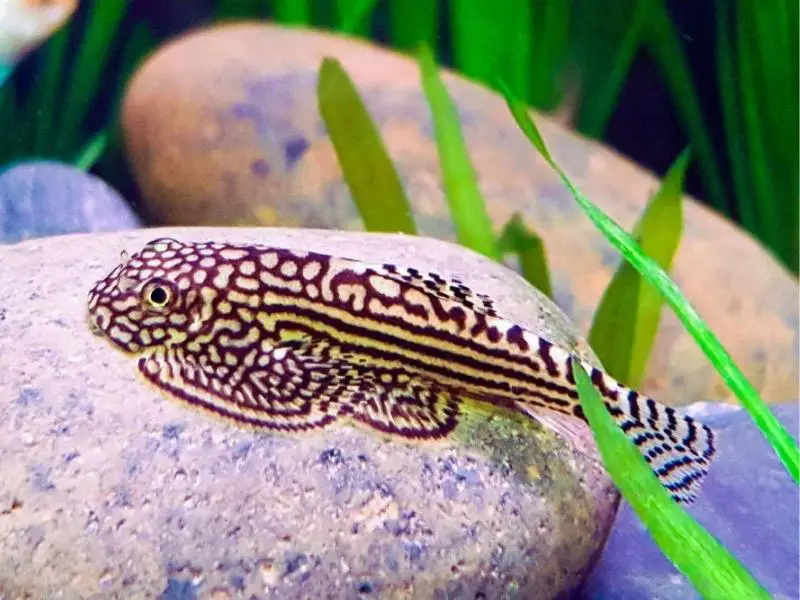
| Care level: | Temperament: | Color: | Lifespan: | Size: |
| Intermediate | Peaceful | Black and yellow spots | 8–10 years | 2–3 inches |
| Water temperature: | Water pH: | Tank size and water type: | Diet: | Scientific name: |
| 68–75°F | 6.5–7.5 | 50 gallons, freshwater | Omnivore | Sewellia lineolata |
The reticulated hillstream loach, Sewellia lineolata, is a freshwater fish native to Laos and Vietnam.
The black and yellow spots spread on the body, and the ridge running along the back gives this algae-eating fish its unique appearance.
Hobbyists and fishkeepers love the reticulated hillstream loach for its interesting appearance and peaceful nature.
Reticulated hillstream loaches don’t have scales on their bodies, which makes them intolerant to water spikes, chemicals and medications, and fluctuating pH levels.
Keep the water within the correct parameters to ensure optimal health and longevity of these unique loaches.
Atlantic Blue Tang
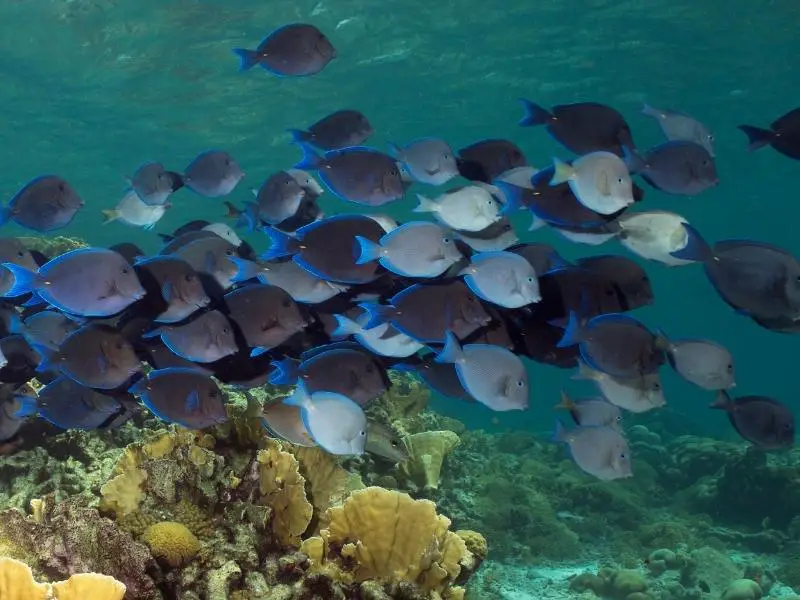
| Care level: | Temperament: | Color: | Lifespan: | Size: |
| Easy | Peaceful | Deep blue | 8–10 years | 2–3 inches |
| Water temperature: | Water pH: | Tank size and water type: | Diet: | Scientific name: |
| 72–80°F | 8.1–8.4 | 150 gallons, saltwater | Herbivore | Acanthurus coeruleus |
The Atlantic blue tang, Acanthurus coeruleus, is a saltwater reef fish native to the coastal waters in the Caribbean Sea and the Gulf of Mexico.
Aquarium hobbyists and marine-aquarium keepers love the Atlantic blue tang for its bright blue coloring, peaceful nature, and hardiness in captivity.
Atlantic blue tangs enjoy a diet containing marine-based algae and plant matter.
Larger, well-established aquariums are more suitable for Atlantic blue tangs as they are prolific grazers with a large appetite for algae and plant matter.
Convict Tang
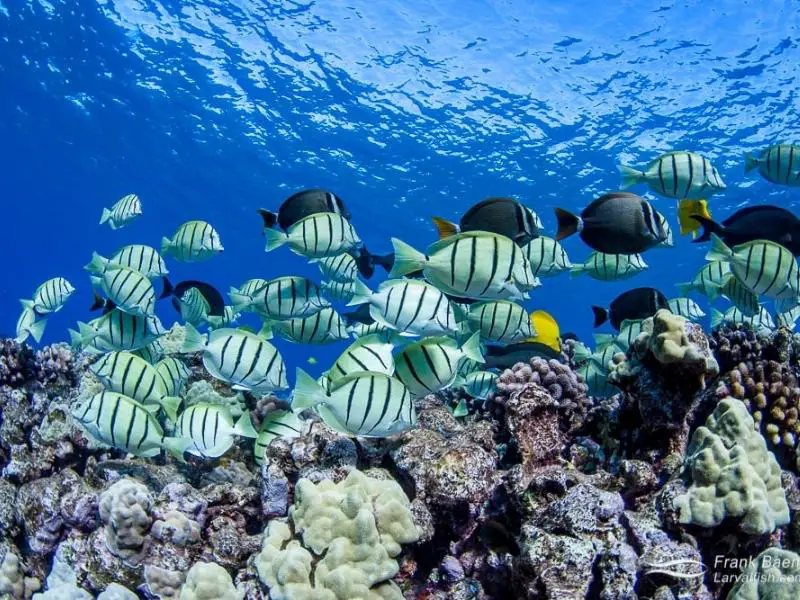
| Care level: | Temperament: | Color: | Lifespan: | Size: |
| Intermediate | Semi-aggressive | black and white stripes | 10–30 years | 7–8 inches |
| Water temperature: | Water pH: | Tank size and water type: | Diet: | Scientific name: |
| 72–78°F | 8.1–8.4 | 100 gallons, saltwater | Omnivore | Acanthurus triostegus |
The convict tang, Acanthurus triostegus, is a saltwater fish found in the Eastern Pacific and Indo-Pacific waters.
Aquarium hobbyists and marine aquarium keepers love the convict tang for its striking black-and-white striped pattern and ability to adapt well to captivity.
Convict tangs feed on filamentous algae, flesh red algae, and blue-green microalgae commonly found on rocks and corals.
Providing a staple diet of marine algae, plant matter, and protein-rich foods ensures convict tangs stay healthy.
Convict tangs are semi-aggressive but mostly peaceful fish and will do well in a large community tank.
Molly Fish
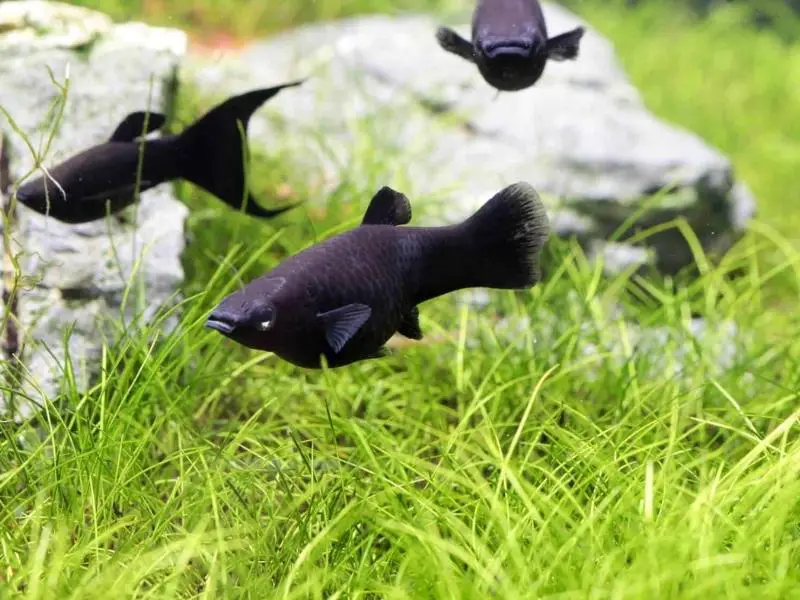
| Care level: | Temperament: | Color: | Lifespan: | Size: |
| Easy | Peaceful | Orange/green/black | 2–5 years | 5–6 inches |
| Water temperature: | Water pH: | Tank size and water type: | Diet: | Scientific name: |
| 75–80°F | 7.5–8.5 | 10 gallons, brackish | Omnivore | Poecilia sphenops |
The molly fish, Poecilia sphenops, is a tropical fish native to Central America, particularly Mexico and Southern USA. Some varieties of molly prefer a freshwater environment, while other types of molly fish live more happily in saltwater.
The molly fish appears in varied colors, tail shapes and patterns, and other physical features.
Mollies are peaceful fish that prefer to swim in schools, but they can also adapt to a community tank with other peaceful fish.
To help freshwater mollies adapt to captivity, add aquarium salt to their tanks to imitate the wild brackish waters of their natural habitat.
Tailspot Blenny
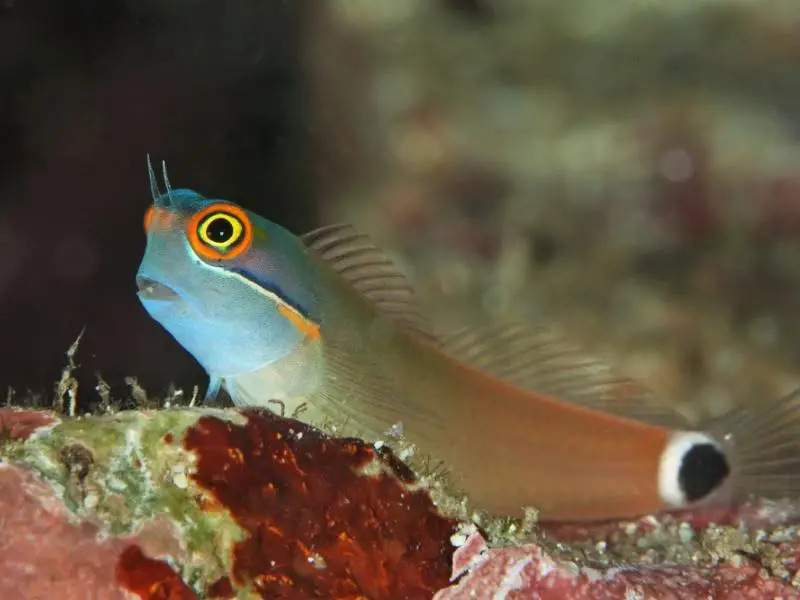
| Care level: | Temperament: | Color: | Lifespan: | Size: |
| Easy | Peaceful | Blue and orange, with yellow, black, white, & brown | 3–5 years | 1.5–2.5 inches |
| Water temperature: | Water pH: | Tank size and water type: | Diet: | Scientific name: |
| 73–81°F | 8.0–8.4 | 10 gallons, saltwater | herbivore | Ecsenius stigmatura |
The tailspot blenny, Ecsenius stigmatura, is a saltwater fish found in the Western Pacific Ocean.
This fish’s vibrant colors, peaceful nature, and fascinating, comical behavior make it a popular choice among aquarium hobbyists and fishkeepers.
Tailspot blennies feed on filamentous algae and microalgae found on live rock.
A diet rich in plant material, microalgae, and blanched vegetables as supplements ensures the longevity and health of these fish.
Tailspot blennies are inquisitive and get along with species of different appearances, but they may show signs of aggression — such as fin nipping — to members of their own species.
One Spot Foxface Rabbitfish
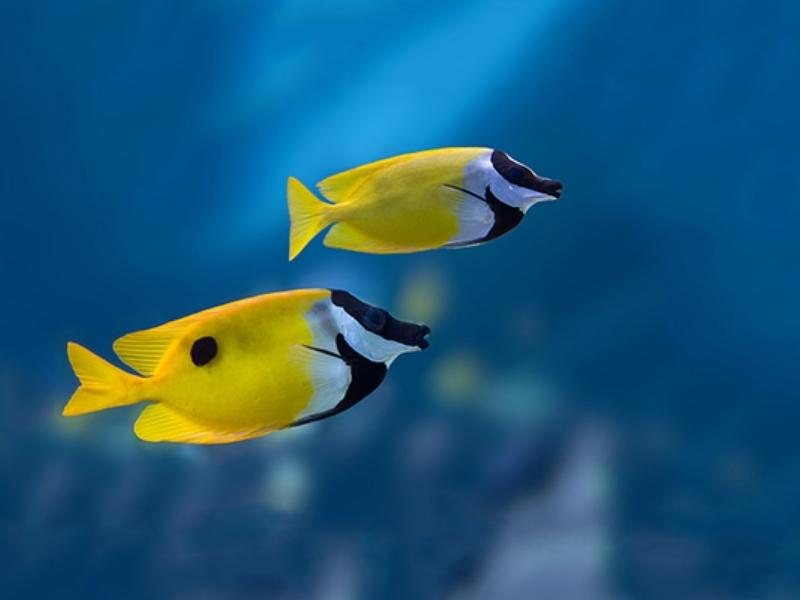
| Care level: | Temperament: | Color: | Lifespan: | Size: |
| Easy | Semi-aggressive | Mottled yellow/brown | 5–7 years | 7–8 inches |
| Water temperature: | Water pH: | Tank size and water type: | Diet: | Scientific name: |
| 72–78°F | 8.1–8.4 | 70 gallons, saltwater | Herbivore | Siganus unimaculatus |
The one spot foxface rabbitfish, Siganus unimaculatus, is a saltwater fish found in the Indian Ocean and the western Pacific Ocean.
The striking color pattern, fascinating behavior, and hardy nature of this fish make it a popular choice for aquarium hobbyists.
One spot foxface rabbitfish feeds on filamentous algae and flesh algae, which both grow on mangroves and corals in the wild.
Provide a staple diet of marine plants, algae, and protein-rich foods to keep this fish healthy.
To prevent territorial aggression, do not keep a spot foxface rabbitfish with other rabbit fishes.
Algae-Eating Shrimp, Snails, and Crabs
Algae-eating invertebrates like shrimp, snails, and crabs can help balance the environment of a home aquarium. When choosing an algae-eating invertebrate, consider whether it will be compatible with the fish in your tank.
Amano Shrimp
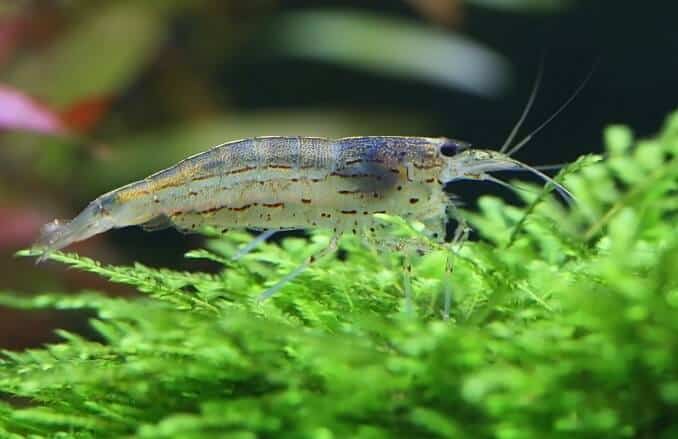
| Care level: | Temperament: | Color: | Lifespan: | Size: |
| Easy | Peaceful | Gray/transparent | 2–3 years | 2 inches |
| Water temperature: | Water pH: | Tank size and water type: | Diet: | Scientific name: |
| 70–80°F | 6.0–7.0 | 10 gallons, freshwater | Omnivore | Caridina multidentata |
The Amano shrimp is a freshwater shrimp native to the streams and rivers of Japan, Taiwan, and China.
These shrimp are one of the most popular algae eaters due to their hardiness, peaceful temperament, and constant habit of foraging for algae to eat.
The amano shrimp is not picky and will eat almost any kind of algae, including hair algae, brush algae, string algae, and even black beard algae. Two amano shrimp per 5 gallons of water is enough to help clean the tank of algae.
Amano shrimp are peaceful and can be housed with other peaceful fish and invertebrates, including guppies, small tetras, betta fish, peaceful barbs, vampire shrimp, and mystery snails.
Cherry Shrimp
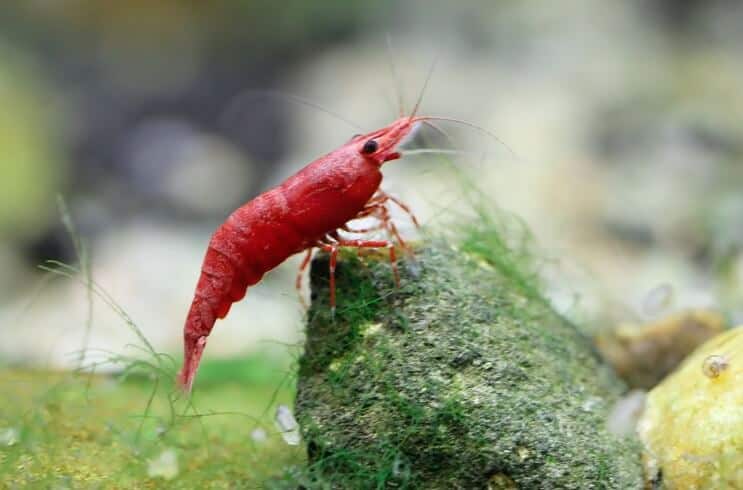
| Care level: | Temperament: | Color: | Lifespan: | Size: |
| Easy | Peaceful | Red | 1–2 years | 1.5 inches |
| Water temperature: | Water pH: | Tank size and water type: | Diet: | Scientific name: |
| 65–85°F | 6.5–8.0 | 5 gallons, freshwater | Omnivore | Neocaridina davidi |
The cherry shrimp is a freshwater shrimp that lives in streams and ponds in South-East Asia.
Cherry shrimp are popular both for their deep appetite for algae, but also for the appearance of their translucent bodies with bright red patches.
These shrimp are peaceful and shy, and should be housed with small, peaceful tank mates that won’t bully or attempt to eat the cherry shrimp. Freshwater snails, neon tetras, Amano and ghost shrimp, dwarf gouramis, and bristlenose plecos are good tank mates for cherry shrimp.
Nerite Snail
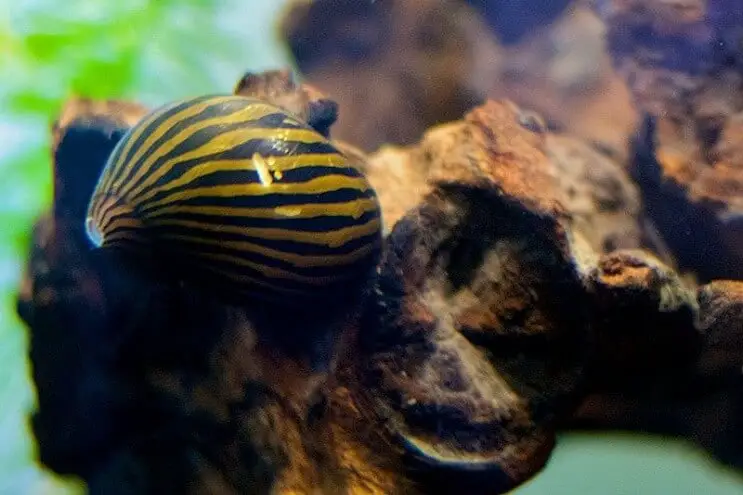
| Care level: | Temperament: | Color: | Lifespan: | Size: |
| Easy | Peaceful | Species dependent | 1–2 years | Up to 1 inch |
| Water temperature: | Water pH: | Tank size and water type: | Diet: | Scientific name: |
| 73–78°F | 6.5–8.0 | 10 gallons, freshwater or saltwater | Herbivore | Neritidae family |
Nerite snails are hardy snails that can live in a wide range of water conditions. Freshwater nerite snails come from brackish waters in Eastern Africa, while saltwater species tend to be from the Pacific or Caribbean coast.
The nerite snail is one of the most popular algae eaters due to its constant appetite for most kinds of algae.
One to two nerite snails can clean an entire 10-gallon tank, and even a 50-gallon tank can be completely cleaned of algae by just five to six nerite snails.
However, when the tank is clean of algae, nerite snails need to be fed in order to stay healthy. They are scavengers and will eat decaying plants or leftover fish food, but to make sure your nerite snails are well-fed, provide sinking algae wafers, blanched vegetables, or aquatic snail food blocks.
Nerite snails can live with peaceful fish that won’t try to eat them, like rasboras, corydoras, and small tetras. Avoid keeping nerite snails with fish that will eat them or pull on their antennae, such as pufferfish and snail-eating loaches.
Cerith Snail
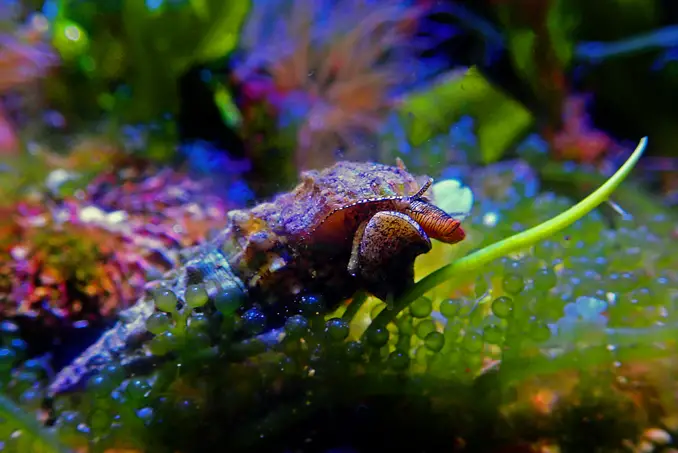
| Care level: | Temperament: | Color: | Lifespan: | Size: |
| Easy | Peaceful | Black, green, white | Up to 3 years | 1.5 inches |
| Water temperature: | Water pH: | Tank size and water type: | Diet: | Scientific name: |
| 72–78°F | 8.1–8.4 | 10 gallons, saltwater | Omnivore | Cerithiidae family |
Cerith snails are a group of saltwater snail species that live in tropical waters all over the world.
The Florida cerith snail (Cerithium litertatum) is the most common cerith snail in the aquarium trade, but all cerith snails are algae eaters. They are also safe for reef aquariums.
The cerith snail grazes on most kinds of algae and detritus in an aquarium. Like nerite snails, cerith snails need to be fed once the aquarium is clean of algae. Provide sinking algae wafers or aquatic snail food blocks at night, when cerith snails are most active.
Cerith snails need small, peaceful tankmates. Avoid keeping them with snail-eating fish. Do not keep a cerith snail in the same tank as a hermit crab, because the hermit crab will try to take the cerith snail’s shell.
Astraea Snail
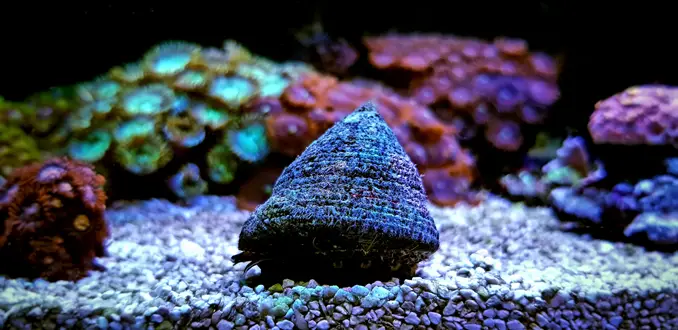
| Care level: | Temperament: | Color: | Lifespan: | Size: |
| Easy | Peaceful | Green | Up to 5 years | 1 inch |
| Water temperature: | Water pH: | Tank size and water type: | Diet: | Scientific name: |
| 72–78°F | 8.1–8.4 | 5 gallons, saltwater | Herbivore | Lithopoma tectum |
Astraea snails are saltwater snails that come from the tropical reefs of the Caribbean Sea and the Gulf of Mexico.
The astraea snail feeds off of hair algae, brown algae, and green algae, as well as bacteria that grows on rocks and other surfaces in the tank.
These snails also require snail food pellets or sinking algae wafers to stay healthy in a tank environment.
Astraea snails are solitary by nature, so they are best suited to tanks with no more than one other snail. Do not keep astraea snails with crabs or bottom-feeders who may knock the snails over, because these snails can’t easily right themselves.
Keep astraea snails with peaceful fish who stay near the middle or top of the tank, or peaceful saltwater shrimp. Avoid keeping astraea snails with pufferfish, wrasses, and rays.
Emerald Crab
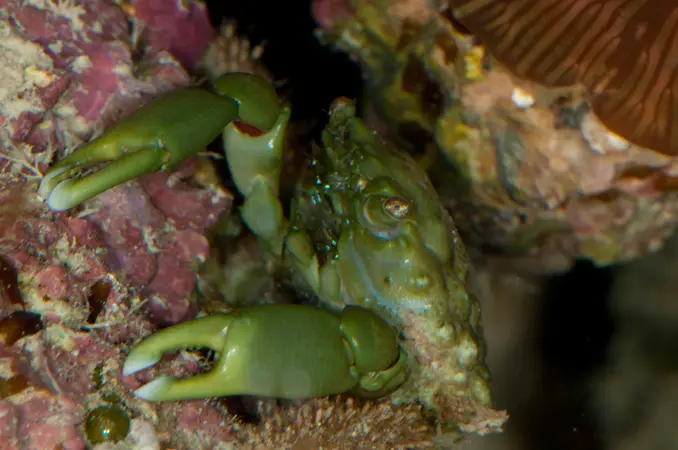
| Care level: | Temperament: | Color: | Lifespan: | Size: |
| Easy | Semi-aggressive | Black, green, white | 1–2 years | 2.5 inches |
| Water temperature: | Water pH: | Tank size and water type: | Diet: | Scientific name: |
| 72–78°F | 8.1–8.4 | 30 gallons, saltwater | Opportunistic omnivore | Mithraculus sculptus |
The emerald crab is a saltwater crab that is native to the reefs of the Caribbean.
Emerald crabs not only eat almost all kinds of algae, but also clean the tank of any kind of meaty waste, such as live food that the tank’s fish leave behind. If your tank has an unwanted snail or shrimp infestation, these small green crabs will solve the infestation by eating the snails and shrimp.
Emerald crabs are mostly peaceful and can be safely kept with most fish, but they will eat other invertebrates like snails, shrimp, and hermit crabs.
If an emerald crab is hungry, it may try to eat coral or even small fish in the tank. As long as the emerald crab is fed often with supplemental food like dried seaweed, chopped shrimp, or fish pellets, it can be kept safely in reef aquariums and with most kinds of fish.
Choosing & Caring For Different Types of Algae Eater
Algae eaters are an important part of the aquarium environment, as they keep algae at bay while keeping the aquarium active and beautiful.
Different algae eaters prefer different surroundings, diets, and temperaments, so be sure to research each type of algae eater before adding it to the aquarium.
Caring for algae eaters in the aquarium involves recreating their natural habitat with appropriate substrates, plants, rocks, and caves.
Keeping the tank water within the correct parameters, including water temperature and chemistry, salinity, and pH level, ensures the algae eater adapts well to the new environment.
When adding an algae eater to an aquarium, choose an algae eater that thrives in the existing water parameters and aquarium environment.
Some algae eaters go well with other types of algae eaters, while others do not. Be sure to match the temperament of the algae eater with the temperaments of the other aquarium fish.

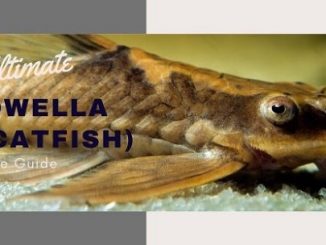
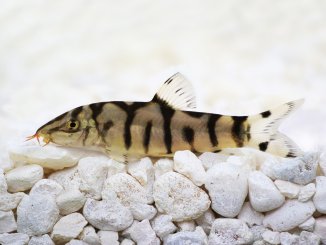
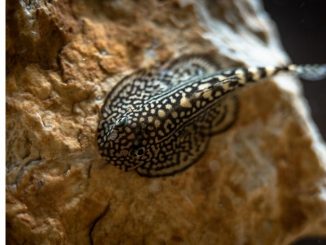
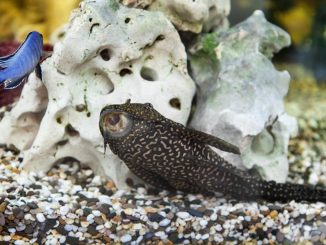
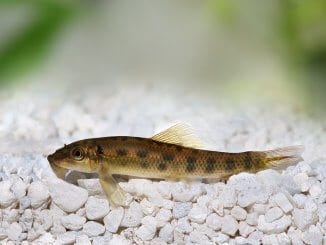
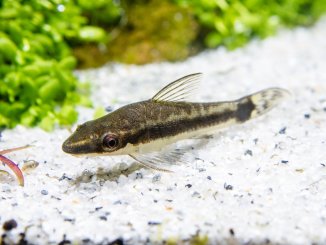
Be the first to comment